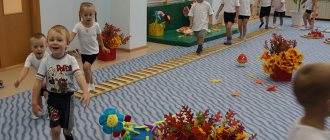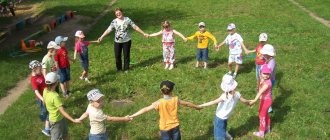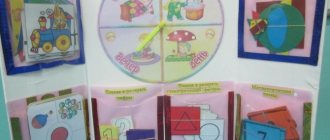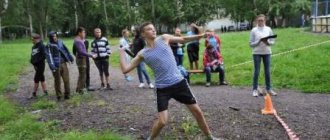Dating games for teens
- Born together - children should find out with whom they have the same or close dates of birth. Then they need to learn as much as possible about each other. At the signal, teenagers take their place and try to give a short story about their new friends.
- Symbol – assign a specific symbol to each teenager. For example, imagine that Olya is an animal. What animal is she associated with? Why? You can associate children with days of the week, products, fruits, months, lessons and so on.
- Guess the name - the presenter asks the participants to say their name so as not to say it directly. Everyone has the right to give two clues about their name, the rest guess. For example, the name is translated “chosen one” - Elena; This was the name of the hero of Pushkin’s novel – Evgeniy; my name is similar to a woman’s jewelry - Sergey (earring).
Dating games in kindergarten, middle group
- I give a toy - the children stand in a semicircle near the teacher with a bag of toys. Each child takes out a toy in turn and says to whom he will give it: “I give the toy to Alena.”
- Pie – children work together to bake a pie. Children say the child's name, and the teacher gives him a task: sift flour, roll out dough, wash fruit, etc.
- For those who are lost , the children stand in a circle. The teacher asks them to close their eyes and takes one child behind a tree, into a gazebo, or behind him. Then the guys open their eyes and guess who is lost.
- Name the name in motion - you need to add the name movement: running Alina, playing Senya.
- Repeat - the child says his name and shows the movement. The second must repeat both the name and the movement. For example, “I am Lyuda”, curtsies, the second child says: “You are Lyuda” and repeats the curtsey.
Dating games in kindergarten, senior group
- My name - the teacher thinks of an action, for example, jump like a hare. Then he asks: “Who is our Rita?” Upon hearing his name, the child stands up and performs the movement.
- Train - the first child rides like a train. Approaches any child from the group to attach the “carriage” to himself. The signal for the hitch will be the name of the sitting child. The game ends when all the trailers are attached to the locomotive.
- Stand up, everyone - the teacher says, and the guys do: “Stand up, everyone whose name is Pavel,” “Stand up, everyone who has the letter O in their name,” etc.
- Affectionate names - the teacher asks the child to name his neighbor on the right with an affectionate version of the name: Igor - Igorek, Marina - Marishka.
- Caterpillar - children, one after another, depict a caterpillar. The “head” turns to the body and asks: “What is your name?” The first part of the “torso” answers and asks further, turning back. Until the caterpillar finds out what names it consists of, the game does not stop.
Conversation with children “I am your new teacher”
- Home /
- Conversation with children “I am your new teacher” /
- Posts /
- Sunflowers /
- Conversation with children “I am your new teacher”
02/22/2017 Conversation with children on the topic : “I am your new teacher ” Goals: - get to know the children; - remember the teacher’s first and middle name; - repeat the rules of behavior in the group; Time: 10 min. Children sit on chairs in a semicircle, the teacher sits opposite them Teacher : - Hello guys! My name is (first name and patronymic), I am your new teacher. Your teacher (first name and patronymic) is now on vacation, she will rest and return to us in September (children’s questions). - Guys, let's repeat my first name and patronymic, please say it yourself, Svetlana Vladimirovna (children repeat). - Fine! And once again we’ll say it all in unison, Svetlana Vladimirovna (children repeat). - Well done. — When we met, we got to know each other a little, now let’s get to know each other better. To do this, we will play the game “Say Your Name.” Game “Say Your Name” Purpose: - To get to know the children; — Learning the patronymic name of the new teacher. Rules and course of the game: The teacher takes a small ball and throws it to one of the children, having caught the ball, the child says his name or his first and last name (at the discretion of the child) and gives the ball back to the teacher. The teacher, having caught the ball, says his name and patronymic, then again throws the ball to the next child and so on until all the children say their names, catching the ball, the teacher each time says his name and patronymic (In order for the children to quickly remember the teacher’s name and patronymic in order not to break the rules of the game). Educator : - Guys, I’m very glad to meet you, now I know your names, and you know mine. You and I will definitely become friends, because now we will be together: studying, studying, playing, having fun, walking, performing at matinees, etc. (children’s addition). And in order for us to live amicably, we will repeat to you the BASIC RULES OF CONDUCT IN A GROUP:
- Obey teachers and assistant teachers;
- FIGHTING, BITING, PINCHING, PUSHING, SPITING, CURRENT - IT IS IMPOSSIBLE!
- Do not break toys and corners, do not tear books;
- Put everything in its place, put away toys;
- For any questions, contact your teacher;
- Respect and help each other.
Educator : - Everyone, everything is clear! (children's answers) - Now we will rest, get up from your chairs, listen to poetry and perform various movements. Physical education lesson: Butterflies fly in the field, flutter over the flowers. (we wave our arms) They flap their wings, They spin and dance. (spinning in place) Butterflies fly quickly, fluttering over the flowers. (we wave our hands) They spin easily and fly high. (circling, arms up) Butterflies are flying everywhere, fluttering over the flowers. (we wave our hands) They flew, they flew - Their wings were tired. (we shake our hands in front of us) Butterflies flew into the field, They sat on the flowers. (sit down). Educator : - Our conversation has come to an end. Well done to all of you! Now, to consolidate the knowledge we have gained, answer me the following questions: What is my name? What can't you do in a group? What can and should be done in a group? Children's answers.
Throughout the conversation , you actively worked and listened very carefully to me and each other.
or leave a review Cancel reply
MAGAZINE Preschooler.RF
Children's games for dating and activating communicationWinner of the all-Russian competition “The most popular article of the month” October 2017
Conditions of the competition:
If everyone gathered often sees each other and is even more friendly, then you probably won’t need to play games from this section. However, even long-time acquaintances can be pleased to once again show attention to each other and remember how they are similar and how they differ from each other. If you invited guys to the holiday who don’t know each other or see each other very rarely, then, most likely, in the first minutes of the celebration there will be some awkwardness and discomfort. In this case, feel free to offer your guests the games described here, since their goal is to relieve tension and tightness, and to arouse children’s trust and interest in other children. You will feel how after their completion the atmosphere in your home has become warmer, more friendly and relaxed.
“Snowball” This game is good to play if there are a lot of children gathered and most of them are unfamiliar. Sit the children in a circle and tell them the name of the game they are about to play. Why is it called that? They will figure it out for themselves now. Pick up an object, such as a small stuffed toy or a marker. State your name. Now pass the marker to the child sitting to your right. He must repeat your name, then add his own and give the item to the third. The third, having received the object, says the name of the first person, the second, and then adds his own, etc. Thus, the last person, before saying his name, will have to remember in order the names of everyone sitting in the circle. That's why the game got its name: the number of memorized names grows from player to player in a circle, like a snowball. Note. During the game, the children, if they don’t remember everyone, will at least have the impression that they know this boy or this girl (they have heard his (her) name many times and pronounced it themselves). “The performance begins” Immediately tell the children that the name of this game has nothing to do with a circus or theatrical performance. As they used to say: “Let me introduce myself!” - that is, to get to know you by saying your name. But today they will not meet in a very traditional way, so it may well happen that it will begin to resemble a circus performance. Have the children stand in a circle. One of them says his name and makes some kind of movement. For example, a child says: “I am Katya” and curtsies. All other children must repeat after him: “You are Katya” and curtsy. Note. Movements do not have to be so beautiful and appropriate to situations. After all, no matter what the child shows, he will receive it in return in “several copies,” which means he has the right to freely choose a gesture after his name, even if it is a fist or a face. “Cheerful greetings” Ask the guys how people usually greet each other. What movements do they make? The spectrum is quite wide: from nods to kisses. Let's focus on the middle option - a handshake. Why do people shake each other's hands? It's just a tradition. Which means everything could have been completely different. For example, Eskimos rub noses instead of kissing. So now we will greet each other in new, unusual ways. So, as soon as you turn on any dance music, the children should start walking around the room (you can also jump and dance). When the music fades away, you say the words: “One, two, three, find a friend!” At this time, each child urgently needs to find a mate and stand next to her. Then you will command - “Say hello ...” - and then name any part of the body. So, during the game, children learn that they can say hello with their ears, little fingers, heels, knees, eyelashes, elbows, etc. Do not forget to set an important condition: every time during a musical pause, the child must stand next to the player with whom he is already didn't say hello at all. Thus, the game can be completed when each guest has said hello to everyone present. Note. If there is an odd number of children, then the one who did not have enough pairs will stand with the adult leading the party and greet him. In this case, you will have the opportunity to clearly show the players that you can say hello, for example, with your heels, if suddenly the children do not immediately figure out how to do this. “The wind blows on the one who...” This game will help you activate your children, and help them feel their similarities with each other, get closer and get rid of awkwardness and tightness. Tell the children that the room has become very hot, it would be nice if there was a breeze. So invite them to play this game. Have everyone stand in a row against one wall of the room. You will say sentences beginning with the words “The wind blows on him who...”. Then add the names of any signs, for example, “who likes apples”, “who washed his face today”, “who is wearing trousers” or “who has pets”. All children to whom the above definition applies must run to the opposite side of the room (preferably there should be a soft, large sofa there), and then calmly return back. When coming up with characteristics that unite children, you can rely on your knowledge of their tastes and lifestyle. This way, you can vary the number of players running to the other side and ensure that each child gets to participate in the game by finding others like themselves. Note. To make it more fun, periodically call out ridiculous signs like “Who didn’t clean their ears today” or “Who will wash the dishes after the holiday” - those who are especially playful and inattentive will set off on their way to everyone’s joy.
| Next > |
Dating games for primary schoolchildren
- Magic brush - use a pen without paste to squeeze out the child’s name on a piece of paper. Then, together with the children, shade the paper with a simple pencil so that the name appears. Ask the guys with that name to stand up.
- Kaleidoscope of names - the teacher names the letters of the alphabet. If a student's name begins with that letter, they must stand up and introduce themselves.
- Parcel - the first participant says: “Clap - the owl’s name - top - the name of the one to whom he passes the baton (parcel).”
- Groups - the teacher invites the children to join groups with classmates with the same names. Those who have a rare name are united in the “Assorted” group.
- Fun tasks - the teacher calls the names of classmates and comes up with tasks for them. For example, Zhenya and Sonya hold hands and jump, Vanya and Lera dance a polka.
Dating games in kindergarten, preparatory group
- Hurricane - children stand in a line. The teacher asks to change those who have something in common (you can start with hair color, T-shirt color). Later names are added: let the guys with the same name or whose name begins with the letter “M” change. At the word “Hurricane” everyone runs to their original places.
- When greeting , you need to shake each other’s hands within a certain amount of time and ask for their name. Then everyone remembers the names of those with whom they greeted.
- Three words about yourself - you need to say your name and describe yourself in three words.
- Squirrel - two parallel lines are drawn on the floor, near which the guys are standing. The teacher asks that those who listen to foreign music be on the right, and those in their native language on the left. Children need to run to the appropriate line without colliding.
- I love - the teacher lists dishes or products, and the child, if he loves him, must clap his hands. This way you can identify with whom children have similar tastes.
Games for dating children and teenagers
Chairs
The guys stand on chairs arranged in a circle. The leader's command is the start to the beginning of the game. Players need to line up in alphabetical order of their names, moving from chair to chair without touching the floor with their feet.
Guess right away
The children sitting in a circle are given a ball. The first player must throw it to any player and say the initial syllable of their name. The player to whom the ball was thrown tries to guess the second syllable of the name. If the answer is correct, the player who threw the ball says his name; if the answer is incorrect, he answers “No” and waits for one of the other participants to guess his name. The game ends when all the guys' names are named.
Find the namesake
Participants in the game need to find their namesakes in order to unite with them into one group. The host gives the signal to start the game, and the guys begin to shout out their names. Victory goes to the most active and fastest.
star Rain
Each of the guys receives a paper star. They must write their name on it. After this, the presenter goes around everyone with a box in his hands. Everyone throws a star into the box and says their name out loud. After all the stars have been collected, the guys take turns pulling them out of the box. Having taken out the star, the player reads the name written on it and gives it to the owner.
Girls-boys
Girls sit in one row, and boys sit in the row opposite. The girls take turns calling the men's names. If there is a boy with that name, he gets up from his chair and talks briefly about himself. When all the boys' names have been guessed, they remember the women's names, trying to guess the names of the girls sitting opposite them.
Remember the name
Several teams are needed for the competition. The game starts with the first team, each player of which says his first and last name and briefly talks about himself. Next, the 2nd team receives cards on which the names of the participants of the 1st team are written. The task of the 2nd team is to find the owners of names among the opponents and give them cards, while calling each one by last name. For each correctly guessed first and last name, she is awarded 1 point. Then the players of the 2nd team are introduced.
Conductor
The participants of the game line up. A conductor is selected and turns his back to the rest of the players. At the conductor’s command “Let’s start the concert!” The guys take turns saying their names. When all the names in a row are called, they begin to call them in reverse order - from last to first (and so on several times). Then the conductor says “Intermission” and turns to face the players. He needs to remember the guys' names. 1 point - for each name correctly named. Next, a new conductor is chosen and the game continues.
Journalist
For the duration of the game (5 minutes), all participants become “journalists”. After they are given paper and a pen and the signal to start the game sounds, the guys begin to ask the others their first and last names, ask about their hobbies, future profession, etc. They write down the answers. The “journalists” who collected the most information win.
The players are divided into two teams. At the signal, the first players of each team run to their “base”, where there are envelopes with the names of the players of the opposing team. The “postman” reads the name on the envelope loudly, the recipient from the other team must respond with the words “It’s me!” Then the “postman” quickly runs to the addressee and hands him the letter. That's what everyone else does. The winner is the team that delivers all the letters the fastest. The organizers can mark the envelopes with short meanings of the names and give them to the participants as a souvenir at the end of the game.
Relay race
There are 2 teams participating in the competition. Before the relay starts, each of the guys comes forward and says their first and last name.
The teams each have a sheet of Whatman paper. The game consists of two stages.
Stage 1. The player runs up to the sheet and writes his last name on it, on the way back he must shout out his name. Players from each team do this in turn.
Stage 2. Teams exchange sheets. Now the task of the competition participants is to write his name opposite the opponent’s last name. The victory goes to the more accurate team.
Secret names
The guys sit in pairs: boy-girl. Before the game starts, the boys tell their names to the girls sitting opposite them, they say in a whisper. The girl from the 1st pair whispers the name of her partner to her neighbor. The other girls shouldn't hear what she says. Next, the girl from the 2nd pair gives the girl from the neighboring pair the names she knows: the boy from the 1st pair and her partner. That's what all the other girls do. The girl from the last pair must name all the boys by name in the correct order. If the boy's name is called correctly, he stands up. Then the girls and boys change roles. The victory goes to the team that correctly names the most names.
Name representation
Guys with the same names unite into groups (Dima with Dima, Olya with Olya). Each group must present its name in an original way.
Examples of tasks for the game:
- Talk about the meaning of your name;
- Draw a name emblem;
- Perform a song or recite a poem in which the name appears;
- Remember outstanding personalities with the same name;
- Come up with a bouquet of flowers whose names begin with the same letter as the name.
Dramatization of names
All children form a circle, one child stands in the middle of the circle. The presenter offers the option: “Forest!” The guys, imagining trees, raise their branches, make noise and repeat the name of the one standing in the circle: “I-van! I-wan!” The second child is represented by “sea”, the third by “road”, the fourth by “bells”, until all names are presented.
Let's brag
Children take turns “bragging” about how they are different from the rest. The presenter suggests: “Think about what kind of person you are? What can you do? What are you good at?” It is advisable not to repeat yourself in the game.
Dating games in kindergarten, junior group
- Whose voice? – the presenter stands with his back to the children sitting in a semicircle. One of the guys must pronounce any word, for example, an object that he sees in the room. The presenter guesses who the voice belongs to.
- Whose things? - The children’s things are put in the box: toys, hairpins, gloves. Then the teacher takes out the item, and the children must name whose it is.
- Find the toy – the toy is hidden in the crib or closet. The teacher prompts: “She is in Katya’s crib,” “The toy is in Lesha’s locker.”
- How to get there - the guys scatter around the group and sit in different places. The second part of the children one by one approaches the teacher and asks: “How to get to Dima? How to get to Polina? The teacher answers: “Take three steps” or “Dima for the flower.”
- Come to us - children are divided into two teams and stand opposite each other at a distance of several meters, holding hands. One team asks the second player, for example, Kolya. He must run between the guys of the opposing team to unclasp their hands. If successful, he takes one of the players to his team, if not, he stands between these players.
Games to bring children and teachers closer together
Games to bring children closer to each other and the teacher.
"Blow up the bubble"
The teacher invites all the children to sit on chairs arranged in a semicircle and asks one of them: “What is your name? Say it loud so everyone can hear you!” The child says his name. The adult repeats it affectionately, takes the child by the hand, approaches the next child with him and asks his name. Repeating the child’s name affectionately but loudly, he invites him to join and give his hand. So all the children take turns holding hands. First I approach those children who express a desire to join the game, and it is advisable to invite the constrained, inhibited children later. If someone still refuses to play, do not insist on it. Gradually watching the game, they will want to be in the team. Children form a long chain. The adult takes the hand of the child standing last and closes the circle. “Look how many of us there are! What a big circle it turned out to be, like a bubble! - says the teacher. “Now let’s make a small circle.” Together with me, the children become a tight circle and begin to “blow the bubble”: they blow into their fists like a pipe, then blow out the air and pronounce the sound “f-f-f”. These steps are repeated 2-3 times. Each time it inflates, everyone takes a step back, as if the bubble has grown a little larger. The children move, and the teacher says the following words: Blow up the bubble, Blow up big, Stay like that, but don’t burst! It turns out to be a large circle, the teacher enters it, touches each pair of joined hands, then stops and says: “The bubble has burst!” Everyone claps their hands, saying “clap” and runs away. After the “bubble bursts,” the teacher says: “Small bubbles flew, flew, flew...” The children scatter in different directions.
Game "Whose voice?"
Children sit in a semicircle, the leader with his back to the playing children. One of the children calls out the name of the leader, who, without turning around, must name the one whose voice he heard.
Game "Catch, Catch!"
A light, easy-to-grasp object is attached to a 50 cm long stick on a cord - a soft foam ball, a bird, a butterfly. Before the game starts, the teacher shows this stick. Lowering and raising it, he invites the children to catch the object on the string. Having interested them in the task itself - catching a ball, the adult invites the children to stand in a circle, and he himself stands in - says the teacher and brings the ball suspended from a stick closer to one or the other child. When he tries to catch the ball, the stick rises slightly and the child jumps up to grab it. Turning in different directions, the teacher tries to involve all the children in this fun. It is acceptable for several guys to catch the object at the same time.







